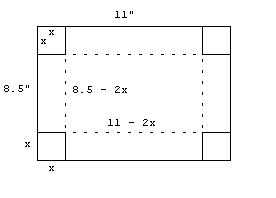Quote of the Day: "Everything tries to be round." -- Black Elk (Holy Man of the Oglala Sioux) Objectives: The student will learn to solve applied maximum minimum problems. 1. Intro We are going to spend a few days solving Applied Maximum/Minimum Problems. I use this when I go to the Mall and try to decide where to park to minimize the distance to two stores. I used this when I parked at Daniel Morgan Middle School to pick up my children (so that their distance to the car would be a minimum). Animals toward the poles have shorter limbs and extremities and rounder bodies ... This minimizes surface area of the body (which minimizes heat loss) - we're talking about penguins and polar bears. When blowing bubbles with various blowers, the bubbles formed exhibit minimum surface area. 2. Experiment: Items Needed: Rectangular sheet of paper (8.5" x 11") for each student Scissors Scotch Tape Rulers Give out a sheet of paper to each student. Have each student cut out squares from each corner (these four squares must be the same size). Then fold up the four sides and tape to form a box. Have each student determine the volume of the box and record results on the board or overhead or computer. Place the results in two columns:
Size of the Square cut out Volume of box --------------------------- -------------- 1" x 1" 58.5 cu.in. 1.5" x 1.5" 66.0 cu.in. 3"x 3" 37.5 cu.in. etc.
Examine the data in the table to find the square that would result in the maximum volume. It should occur between the 1.5" square and the 2" square. Take time to look at various boxes and their volumes. Have students hold up boxes with 1" square cut out, 3" square, etc. 3. Now use calculus to solve the problem: Since we wish to maximize the volume of the box, we need to determine a formula for the volume in terms of one variable. Then we will take the derivative of V and set it equal to zero to find the relative maximum or minimums. Let x = side of the square to be cut out. Then V = (11 - 2x) (8.5 - 2x) x Refer to the diagram.
4. Click here for Fifty Ways To Work A Problem 5. Assignment: Read section 5.5 p. 318 (19, 21) Click here to go to the next page Click here for bubble blowing activity
